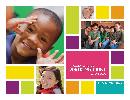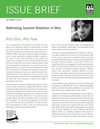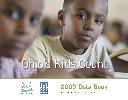|
CDF-Ohio > KIDS COUNT
KIDS COUNT
What is KIDS COUNT?
KIDS COUNT Publications
KIDS COUNT Data Book
Ohio KIDS COUNT Data Book
Juvenile Justice for Ohio's Children?
KIDS COUNT Projects
Ohio County Fact Sheets
Demographic and Programmatic Maps
Other KIDS COUNT-Related Resources
Community-Level Information on Kids (CLIKS) Database
What is KIDS COUNT?
KIDS COUNT, a project of the Annie E. Casey Foundation, is a national and state-by-state effort to track the status of children in the U.S. By providing policymakers and citizens with benchmarks of child well-being, KIDS COUNT seeks to enrich local, state, and national discussions concerning ways to secure better futures for all children.
In addition to providing an annual Data Book with state-level benchmarks for the educational, social, economic, and physical well-being of children the Foundation funds a network of state KIDS COUNT projects to provide a local picture of child well-being. By providing the public with information on the needs and problems of children, KIDS COUNT seeks to enhance discussions about how to secure better futures for them.
KIDS COUNT Publications
 Ohio's KIDS COUNT: 2010, Released Ohio's KIDS COUNT: 2010, Released
The Ohio’s KIDS COUNT: 2010 Data Book, provides the most current and accurate data that tracks and compares the well-being of children in Ohio and its 88 counties. The data book contains important data and a summary of the trends regarding 14 key indicators of child well-being in the categories of economic security, health, education and safety. Helpful charts provide a comparison of state and county data, with links to additional resources. Also included in each section are highlights of programs and promising practices being implemented to improve the well-being of Ohio’s children.
 National KIDS COUNT 2010 Data Book National KIDS COUNT 2010 Data Book
According to data in the 21st annual KIDS COUNT Data Book, overall improvements in child well-being that began in the late 1990s stalled in the years just before the current economic downturn. Find national data and state-by-state data and rankings on 10 key indicators of child well-being.
 Issue Brief: Juvenile Reform in Ohio
Issue Brief: Juvenile Reform in Ohio
The Children’s Defense Fund – Ohio, the Children’s Law Center, Inc., Voices for Ohio’s Children and the Juvenile Justice Coalition – Ohio are collaborating to increase awareness and support among key stakeholders and the general public for juvenile pretrial detention reform in Ohio. Related to that effort is the release of the Rethinking Juvenile Detention in Ohio Issue Brief and the related Juvenile Detention Reform in Ohio Fact Sheet which outline the current research and impact of juvenile pre-trial detention. Both documents support the adoption of alternatives that will keep youth out of pretrial detention whenever possible, while maintaining community safety. Both publications are products of CDF - Ohio’s KIDS COUNT project.
To learn more about KIDS COUNT and for more information, please see our CDF-Ohio KIDS COUNT program.
 Ohio's KIDS COUNT: 2009 Ohio's KIDS COUNT: 2009
The Ohio’s KIDS COUNT: 2009 Data Book, provides the most current and accurate data that tracks and compares the well-being of children in Ohio and its 88 counties. The data book contains important data and a summary of the trends regarding 14 key indicators of child well-being in the categories of economic security, health, education and safety. Helpful charts provide a comparison of state and county data, with links to additional resources. Also included in each section are highlights of programs and promising practices being implemented to improve the well-being of Ohio’s children.
 KIDS COUNT 2009 Data Book KIDS COUNT 2009 Data Book
The 2009 KIDS COUNT Data Book provides a national and state-by-state profile of the well-being of America's children. The Data Book ranks states on 10 key measures and provides data on the economic, health, education and social conditions of America's children and families. This year’s KIDS COUNT Data Book essay, "Counting What Counts," calls for a "Data Revolution" to track progress and improve the lives of vulnerable kids. Visit the Annie E. Casey Foundation’s KIDS COUNT Data Center website to access the data book, view state profiles and read the essay.
 Ohio's KIDS COUNT: 2008 Data Book Ohio's KIDS COUNT: 2008 Data Book
Ohio's KIDS COUNT: 2008 Data Book is a compilation of the most current and accurate data that tracks and compares the well-being of children in Ohio and its 88 counties. The Annie E. Casey Foundation’s KIDS COUNT project has provided support for this publication. The data book contains important data regarding 14 key indicators of child well-being in the categories of economic security, health, education and safety. Each category features state and local information along with a summary of the trends for the child well-being indicators. Helpful charts provide a comparison of state and county data, with links to additional resources. Also included in each section are highlights of programs and promising practices being implemented to improve the well-being of Ohio’s children.
An added feature of the book is a focus on the Ohio implementation of Healthy People 2010 (HP 2010), the federal initiative in the United States that provides set objectives for measuring the health of the population. HP 2010 has twenty-eight focus area chapters that are intended to achieve two broad goals: increase quality and years of healthy life and eliminate health disparities.
 Ohio's KIDS COUNT: 2007 Data Book Ohio's KIDS COUNT: 2007 Data Book
Ohio's KIDS COUNT: 2007 Data Book is a compilation of data that tracks and compares the well-being of children in Ohio and its 88 counties. The data book focuses on 14 indicators of child well-being in the categories of economic security, health, education and safety. These indicators are monitored annually to track the status of how well children fare in Ohio.
 Juvenile Justice for Ohio's Children? Juvenile Justice for Ohio's Children?
CDF-Ohio's 2006 Data Book, Juvenile Justice for Ohio's Children? highlights how Ohio has improved its support of children in recent years but continues to lag behind most states in terms of juvenile justice because minorities are disproportionately represented and there is a lack of basic treatment services for all children.
 Ohio & Kinship Care Ohio & Kinship Care
Ohio & Kinship Care: The Challenge for Grandparents & Other Caregivers is the first in a series of issue briefs being published and released by the CDF-Ohio KIDS COUNT program. The series of issue briefs will provide information and data that will help with advocacy, policy development, and decision-making affecting the well-being of Ohio’s children. Ohio & Kinship Care provides information on the status of grandparent caregivers in Ohio. Although a kinship caregiver can be a family member or close friend of the child, the information in this issue brief focuses on grandparent caregivers and the grandchildren in their care because this is the only population for which data is currently available.
 Halting the Loss of Millions of Dollars in Earned Income Tax Credit Benefits from Ohio Halting the Loss of Millions of Dollars in Earned Income Tax Credit Benefits from Ohio
Halting the Loss of Millions of Dollars in Earned Income Tax Credit Benefits from Ohio is an issue brief published and released by the CDF-Ohio KIDS COUNT program.
According to data from the Internal Revenue Service (IRS), more than 797,000 Ohio taxpayers received the Earned Income Tax Credit (EITC) in tax year 2005, representing a $1.4 billion investment in Ohio families, individuals, and the community in which they live and work. Regrettably however, hard-working Ohioans lose a significant portion of their refund when they visit commercial tax preparers and purchase Refund Anticipation Loans (RALs). Tax preparation fees, RALs and other commercial products used to access tax refunds drained $104 million dollars from EITC benefits in tax year 2005; $3 billion was diverted nationally.
This issue brief highlights the financial loss endured by hard-working Ohioans to tax preparation businesses, examines trends in RAL usage and provides an overview of four key measures that would help Ohio families keep the money they have earned and reduce child poverty.
 The Face of Health Disparities Among Children in Ohio The Face of Health Disparities Among Children in Ohio
The Face of Health Disparities Among Children in Ohio exposes significant health disparities and inequitable access to health care among Ohio’s racial minority and low-income children. According to the report, women from the most impoverished counties in Ohio are giving birth to low birthweight babies at the highest rate. Disproportionately, these children also experience a higher incidence of disease, poor oral health, childhood obesity and unmet mental health needs.
This issue brief examines trends in health outcomes among children in Ohio, highlights the barriers to an equitable system of care and provides an overview of four key strategies to help ensure all children and pregnant women in Ohio, access to comprehensive health care.
Children Who Witness Domestic Violence
 CDF-Ohio released the issue brief, Children Who Witness Domestic Violence, to increase awareness of the effects of domestic violence on those children who are witnesses to the violence. CDF-OH hopes to improve the understanding and support throughout Ohio to end family domestic violence and generate a shared vision to protect our children. By paying attention to these children now, we can help stop the cycle of domestic violence once they become adults. The issue brief provides an overview of the problem, the effects domestic violence has on children, domestic violence programs and recommendations and a call to action. CDF-Ohio released the issue brief, Children Who Witness Domestic Violence, to increase awareness of the effects of domestic violence on those children who are witnesses to the violence. CDF-OH hopes to improve the understanding and support throughout Ohio to end family domestic violence and generate a shared vision to protect our children. By paying attention to these children now, we can help stop the cycle of domestic violence once they become adults. The issue brief provides an overview of the problem, the effects domestic violence has on children, domestic violence programs and recommendations and a call to action.
KIDS COUNT Projects
The Annie E. Casey Foundation funds KIDS COUNT projects in each state to raise awareness and accountability for the condition of children and families. As the state-level grantee in Ohio, CDF-Ohio develops data-driven products for use by the public including fact sheets for each of Ohio's 88 counties as well as maps displaying this demographic and program-related data.
Other KIDS COUNT-Related Resources
KIDS COUNT Data Center (formerly CLIKS)
To provide a more detailed picture of the condition of children and families, the Annie E. Casey Foundation maintains a database known as KIDS COUNT Data Center. The new KIDS COUNT Data Center provides a wealth of information about the children and families living in your state, city, county and school district, including the information formerly in the Community-Level Information on Kids (CLIKS) site.
|

 National KIDS COUNT 2010 Data Book
National KIDS COUNT 2010 Data Book

 KIDS COUNT 2009 Data Book
KIDS COUNT 2009 Data Book Ohio's KIDS COUNT: 2008 Data Book
Ohio's KIDS COUNT: 2008 Data Book




